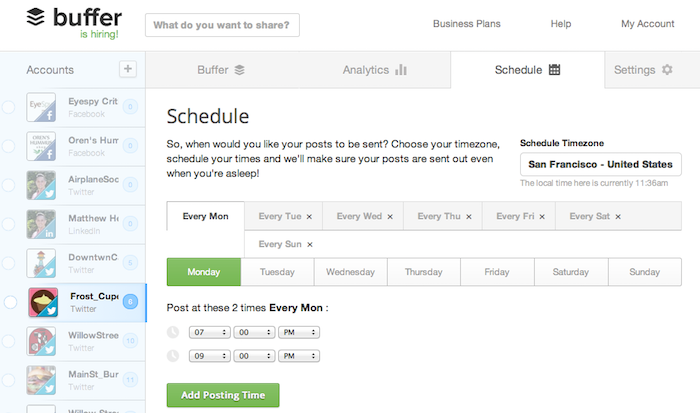Small business social media accounts are only as effective as the strategies behind them. In this article, we review the core components of every successful social media strategy.
Social media has come a long way since the days of MySpace. Today, influencers, e-commerce integrations, and sticky features make social media an inescapable part of life.
Businesses now jump at social media’s new features to promote their brand.
Today, brands are not only using social channels to communicate with customers. They are further making use of this medium–to promote their products and services.
Some businesses, however, still choose not to use social media because it can be demanding to constantly create and produce content.
Businesses must plan when and how to reach potential customers on social media to be successful.
Creating a comprehensive social media plan before launching will help your business maintain a strong social presence in the long term.
Here are a few tips you can follow to streamline your social media process and market your brand to a wide audience:
How to Create a B2B Social Media Strategy for Your Small Business
- Create a content calendar
- Understand your competitors
- Plan your brand presentation
- Create captions and hashtags
- Choose the right tools
- Purchase advertisements
1. Create a Content Calendar
Businesses of all sizes can use social media channels such as Facebook, Instagram, and LinkedIn. It’s important, however, to make sure you have a strategy in place for each platform.
Before launching your business profiles, you must decide when to must post regular updates, or run ads on Facebook and Instagram to reach your customers.
Facebook ads, for example, appear in the regular Facebook feed but can be targeted based on a users' specific interests.

Facebook ads are an important part of a content schedule. A content schedule ensures you're not serving users with too much content.
To get started, consider scheduling one day of the week for posting content. Then check their performance every few days.
When promoting your product or brand, find which social media channels make the most sense.
You don’t have to be on every platform, but make your presence count on the ones you choose.
Try to identify where your customers or potential customers are most likely to be found. Google Analytics data can be used to help you.
By doing this, you can focus your attention on the channels that will produce the best results.
2. Plan Your Brand Presentation
The appearance of your business matters a lot. Social media is one of the first places customers will experience your brand before visiting your website.
Make sure to plan how you’ll present your brand and company on social media.
A low-resolution image for your products might look sloppy on users’ devices.
Don’t waste your hard work on images that aren’t the correct size. When you upload images on different platforms, ensure that they are posted in the platforms’ recommended size (both the height and width).
For reference, here’s a handy guide for all of Facebook’s image size requirements.
3. Create Captions and Hashtags
Businesses can improve their campaigns with good captions and punch lines.
Captions that are catchy attract viewers to read about your products. As a result, creative writing skills are a must for maintaining a positive reputation on social media.
You should also consider having someone proofread your content (remove mistakes, repetitive words, etc.). Another tip, try to write unique captions unlike those written by others. While the same caption may work for one business, it may not for yours.
Hashtags are a core component of any social media post. They help to boost your reach by allowing customers to find your relevant content. For example, consider you are posting about Inter Ballistic Missiles, but you use the hashtag #IBM.
You know what users searching the hashtag are expecting – International Business Machines.
As an alternative, you could create a new hashtag like #InterBallisticMissiles. When creating a hashtag, businesses can include a company name or slogan such as #BensResto or #BestPizzaInTown.
4. Understand Your Competitors
Before you create a campaign, ensure you know your target audience. You should have a reasonable understanding of your customers’ likes and dislikes.
If you’re not sure, consider creating a poll to gather information. More so, you could arrange a contest to entice users for filling out a survey about themselves.
Be aware of your competition. Keep a close eye on their activities like growth in social media metrics, the hashtags they use, and most importantly how successful their campaigns have been.
Your customers will always prefer quality. There’s just too much noise on social media to compete with low-quality content.
Focus on quality content that excites your customers, and retain them for the long-term.
5. Choose the Right Tools
Don’t waste your time using tools from the past. Use the latest tools to save you time and yield better results.
One example is Buffer, which allows you to schedule posts in advance across all relevant social media channels.

Don’t just create posts and move on. Keep an eye on them. You should see how followers are responding.
Take learnings from your best performing posts, and apply them to your future posts.
The best time to get started on social media is yesterday. But it’s not too late. Get started today and start building your online presence.
6. Purchase Ads
Ads are the next step in social media. Running ads allows you to increase your range and reach of customers.
You can get started with as little as $5 per day. Paying $5 can help you reach a limited audience.
Once you prove your ad’s effective, consider increasing your budget and 10x+your audience.
Strategy Is Crucial for Small Business Social Media
Regardless of your company's size, social media helps you connect with the potential customers and increase awareness of your brand.
Remember: you need to take a focused approach to build your social media marketing efforts over time.